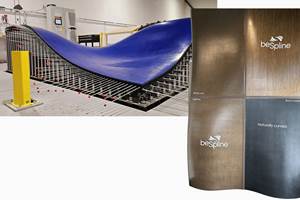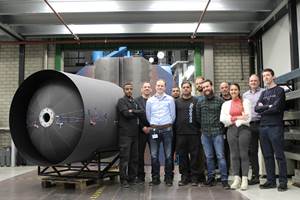Data infrastructure in composites manufacturing: A growing need
As more automation enters the fabrication process for composites, new data infrastructure is required to guide that automation.
In recent conversations at industry events, I have encountered a growing number of composites engineers who look bewildered when I mention mylar and fiberglass templates. Although this trend is a disconcerting sign of my lengthy career, more significantly, it underscores the advancements our industry has made in data infrastructure. In composites manufacturing, data infrastructure is the means by which design and manufacturing data are communicated to the workcell to guide and monitor fabrication of actual components. As more automation enters the fabrication process, new data infrastructure is required to guide that automation. Importantly, I believe, only those companies that build out their data infrastructure will be able to take full advantage of the automation technologies that are driving composites fabrication to new levels of efficiency and quality. This is true of automation technologies ranging from those that assist hand layup to those that complete entire fabrication processes.
Those mylar and fiberglass templates of the 1980s intermediated between the virtual CAD realm and the real world of component fabrication. Shaped to match a specific 3D pattern in a ply schedule, each template had to be lifted into place, carefully aligned and pinned to the tool. An operator then scribed the template’s outline. After removing the template, the operator could then lay up the ply. This sequence was repeated for each ply — often hundreds of times to build one component. Both painstaking and inflexible, this fabrication process also pitted throughput against quality; that is, raising the manufacturing rate almost inevitably reduced component quality.
In the 1990s and early 2000s, the first data infrastructure elements lopped months or years off product development cycles, and days or weeks off manufacturing cycle times. Simultaneously, they improved the quality and consistency of composite components. Directly accessing and using design and manufacturing data, 3D industrial laser projection systems (which Aligned Vision introduced in 1988) replaced physical templates with “templates of light.” Serving as data infrastructure, these laser templating systems communicated data in a useful form to the fabrication workcell. Inspectors also gained valuable help, because laser projectors could display nominal edge locations, fiber orientations and other ply features. However, data flowed in only one direction through this infrastructure; inspector stamps or initials were the only information coming back from the as-built component.
Starting in the early 2010s, data began to flow back from the component, as more data infrastructure eliminated time-consuming alignment of the templating system in automated workcells, such as automated fiber placement (AFP) systems. Partnering with laser projection providers, makers of automated workcells employ a software development kit (SDK) to fully integrate laser projection. The integrated system uses manufacturing data to automatically calculate the position of each point on the workpiece relative to the laser projector, thus keeping the projection system aligned even when an asymmetrical part is translated or rotated along different axes. In this application, a second party — the workcell developer — contributes to the data infrastructure.
With the recent introduction of automatic inspection systems, yet another party — the fabricator — now can play a vital role in data infrastructure development. Aligned Vision, for example, began developing automatic inspection in 2000, with automatic ply verification (APV), which verified and documented flight-critical characteristics on spars and skins. APV marked the beginnings of bi-directional data infrastructure, automatically generating quantitative quality data from the shop floor.
Today, Aligned Vision’s automatic inspection systems incorporate a laser projector and a high-magnification, high-resolution camera. The camera captures detailed images that may include laser reference lines, and the laser projector pinpoints out-of-tolerance features for rework. To analyze the captured images, the system uses analysis algorithms tailored to specific materials and component features. This is where the fabricator and inspection system provider must work closely together to equip the system with required information and programming (i.e., data infrastructure).
Automated inspection adds value to the fabrication process through accelerated, high-quality fabrication and through full traceability provided by as-built electronic documentation. Yet the value-adding capacity of automatic inspection is still in its infancy. The next advancement in data infrastructure will feed inspection data to Smart Factory technology, which will enable fabricators to quickly detect opportunities and implement process improvements. For example, the automatic acquisition of as-built fiber orientations in first articles will enable analysis of actual part parameters rather than the nominal, thus decreasing the need for overdesign to account for manufacturing variation.
It is my observation that industries cannot optimize their processes and products unless they optimize their organization. In composites manufacturing, companies that progress toward implementation of Big Data — those that build out their data infrastructure — will move toward such optimization, and likely will be the big winners in our future marketplace.
About the Author
Scott Blake
Scott Blake is president of Aligned Vision (formerly Assembly Guidance, Chelmsford, MA, US). Among the leaders in 3D industrial laser projection, his company developed numerous industry “firsts,” including multitasking laser systems, full workcell integration and automatic inspection. His work on the USAF’s Composites Manufacturing Process Control System garnered him a 2000 National Tibbetts award.
Related Content
Manufacturing the MFFD thermoplastic composite fuselage
Demonstrator’s upper, lower shells and assembly prove materials and new processes for lighter, cheaper and more sustainable high-rate future aircraft.
Read MorePlant tour: BeSpline/Addcomp, Sherbrooke, QC, Canada
Composites automation specialist increases access to next-gen technologies, including novel AFP systems and unique 3D parts using adaptive molds.
Read MoreAirborne delivers composite upper stage tank for EU ENVOL project
Nine-member consortium targets development of low-cost, green vertical orbital launcher with manufacture of an ultra-lightweight composite tank design in an automated manufacturing environment.
Read MorePlant tour: Middle River Aerostructure Systems, Baltimore, Md., U.S.
The historic Martin Aircraft factory is advancing digitized automation for more sustainable production of composite aerostructures.
Read MoreRead Next
Developing bonded composite repair for ships, offshore units
Bureau Veritas and industry partners issue guidelines and pave the way for certification via StrengthBond Offshore project.
Read More“Structured air” TPS safeguards composite structures
Powered by an 85% air/15% pure polyimide aerogel, Blueshift’s novel material system protects structures during transient thermal events from -200°C to beyond 2400°C for rockets, battery boxes and more.
Read MoreVIDEO: High-volume processing for fiberglass components
Cannon Ergos, a company specializing in high-ton presses and equipment for composites fabrication and plastics processing, displayed automotive and industrial components at CAMX 2024.
Read More











.jpg;maxWidth=300;quality=90)








